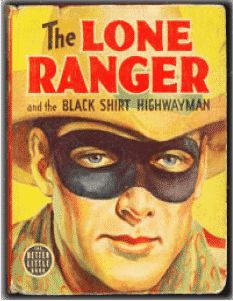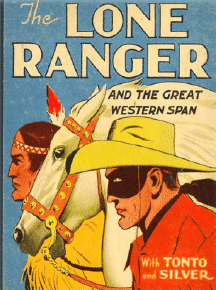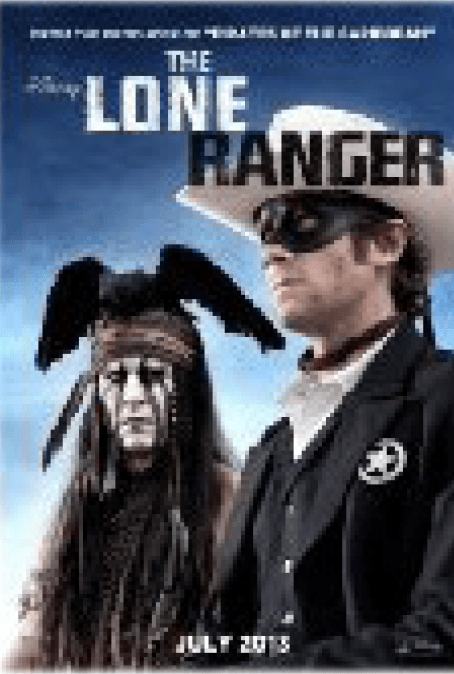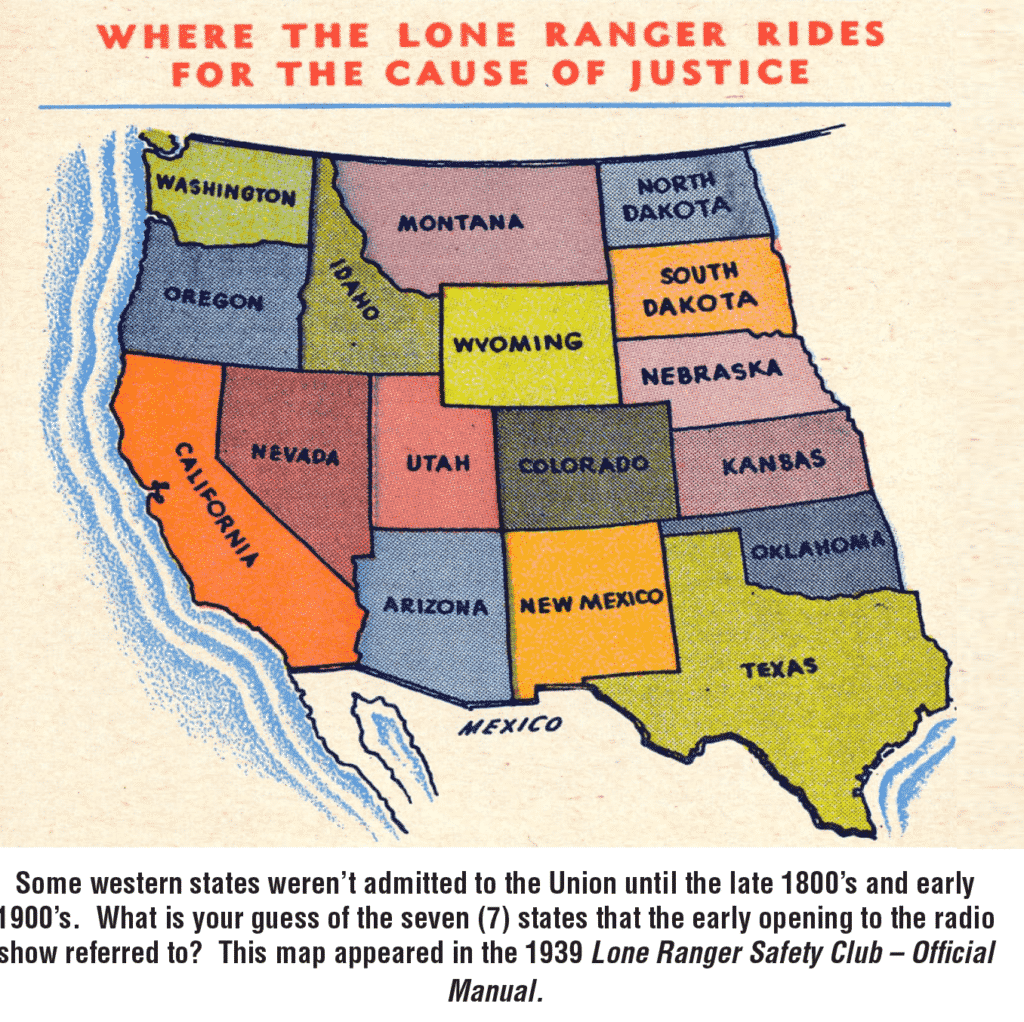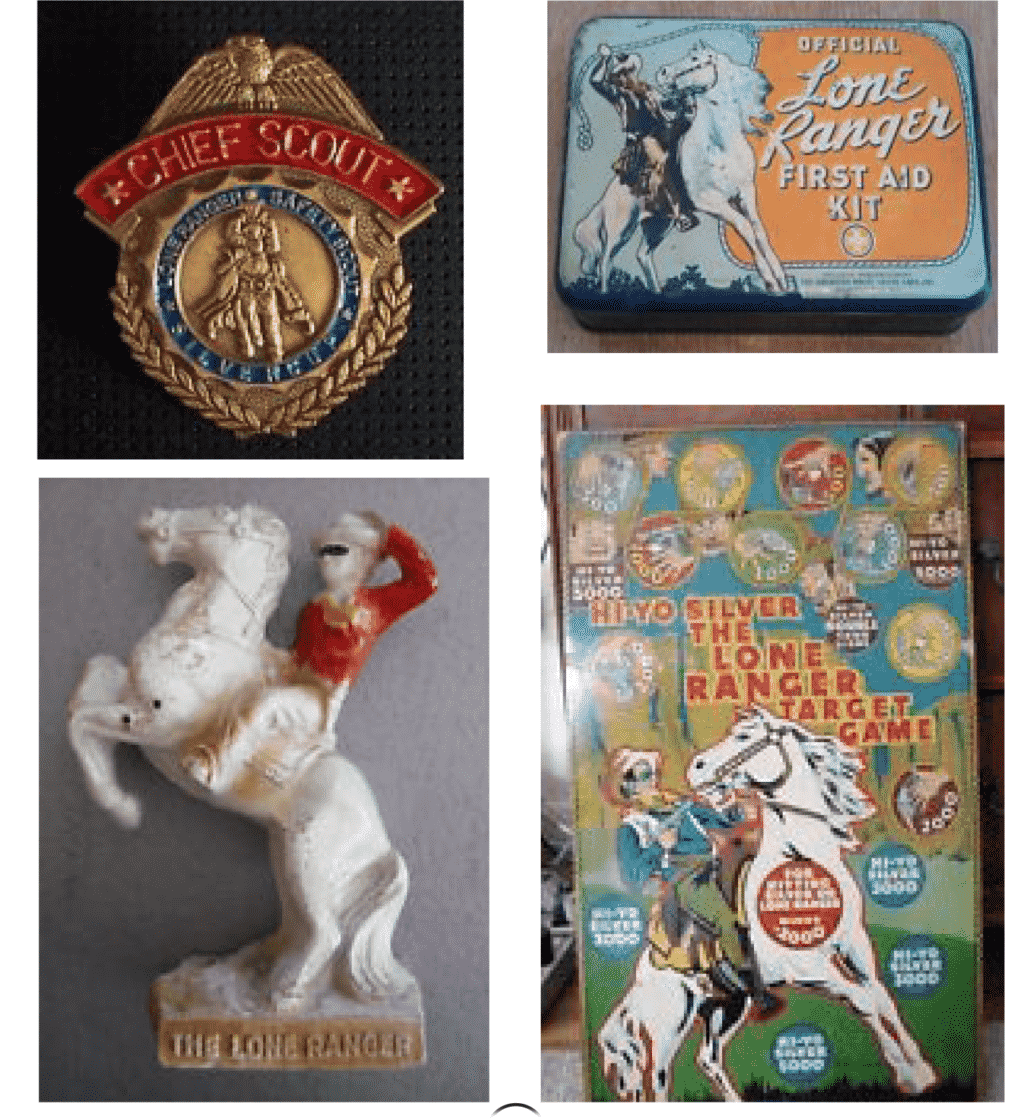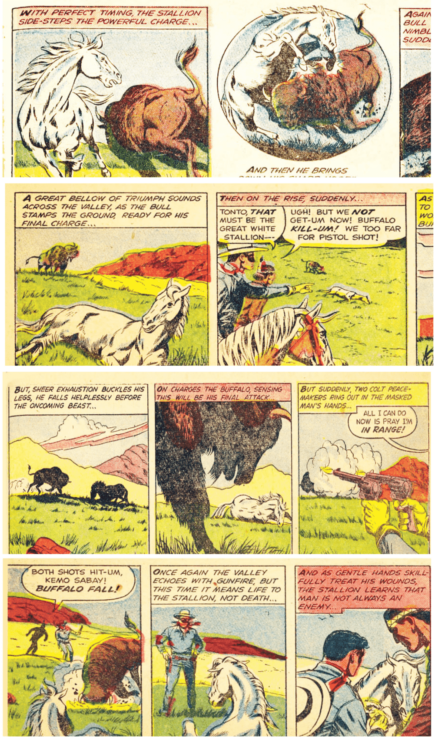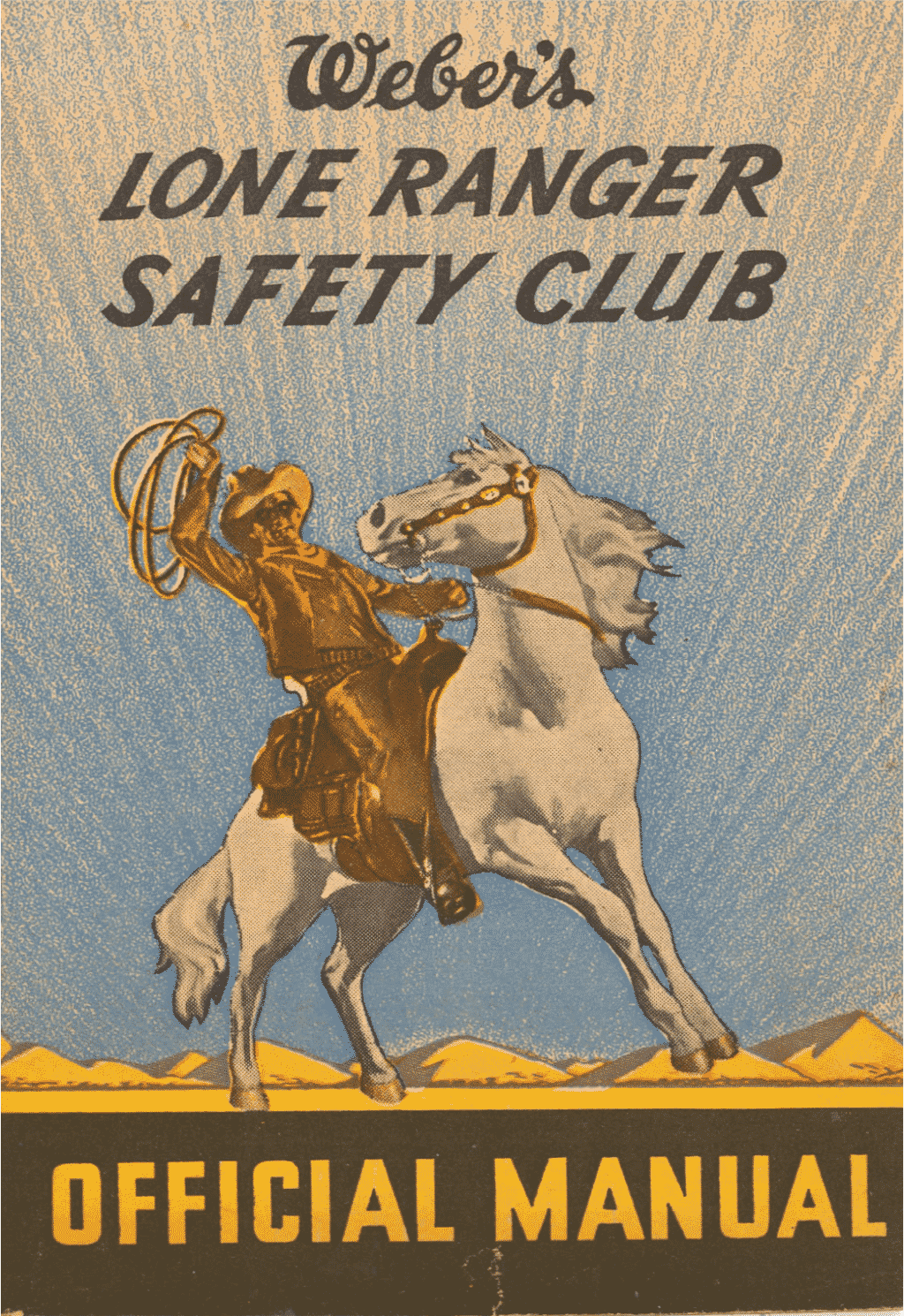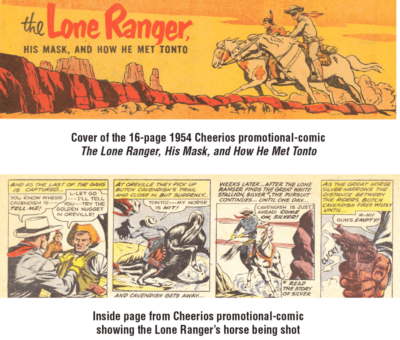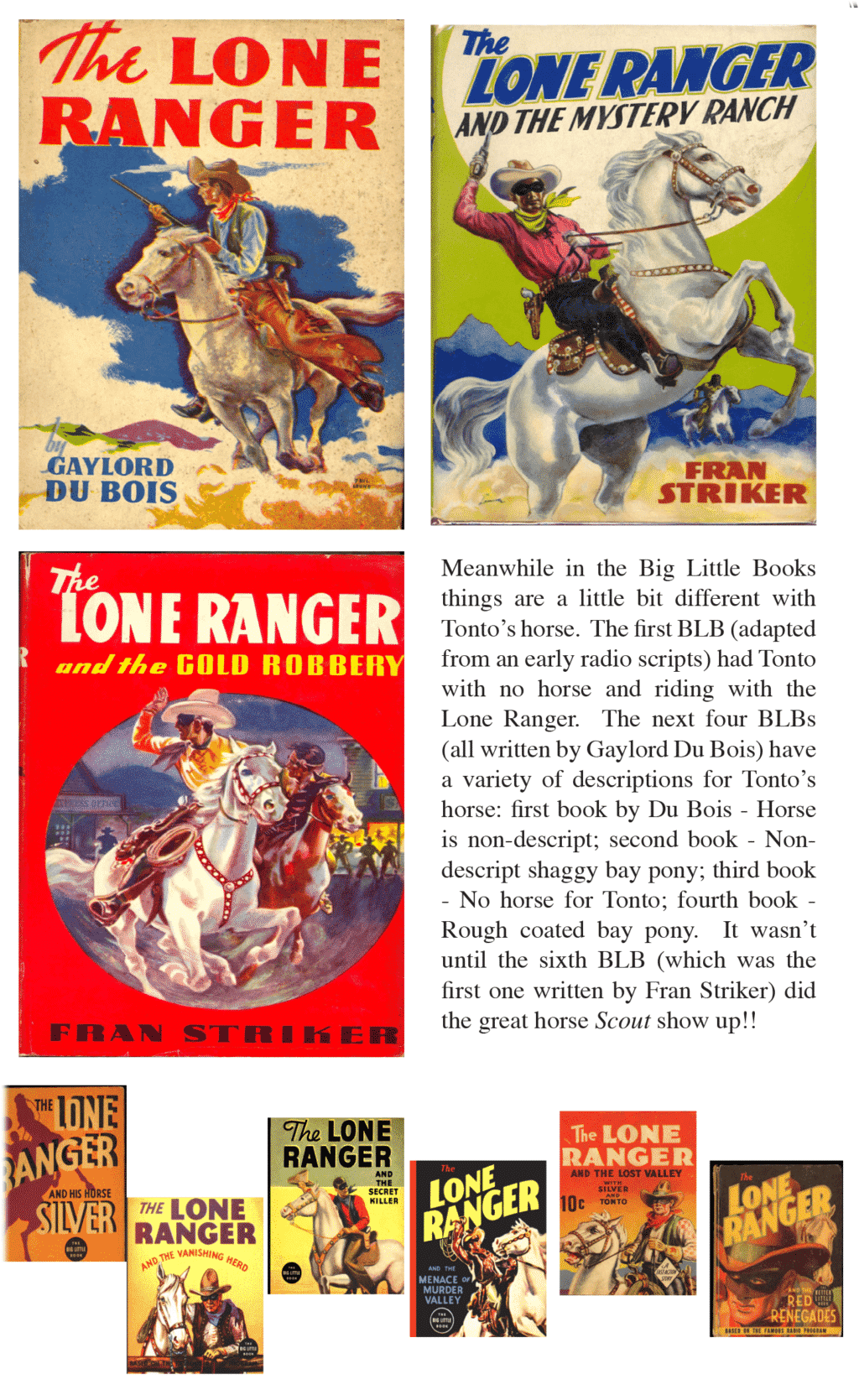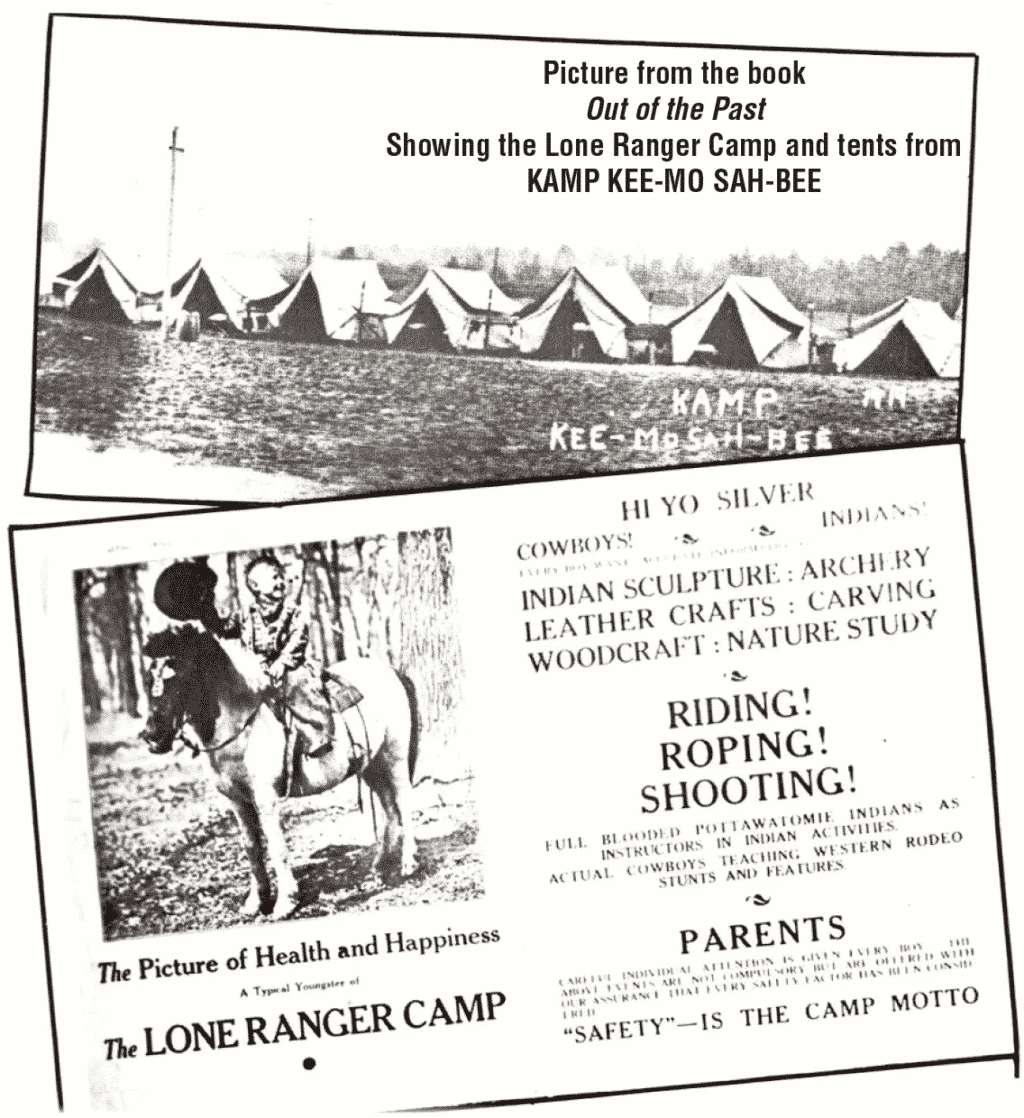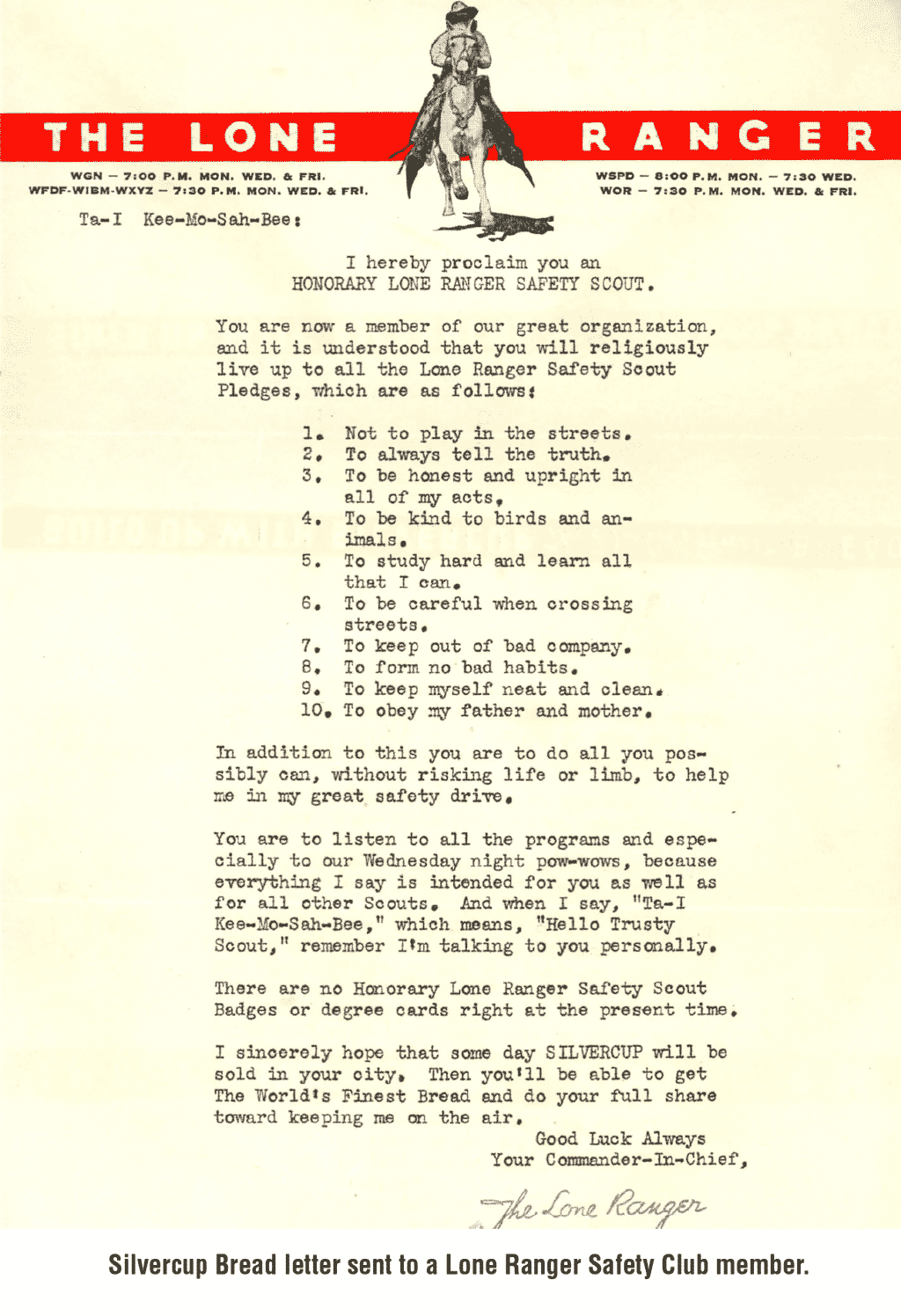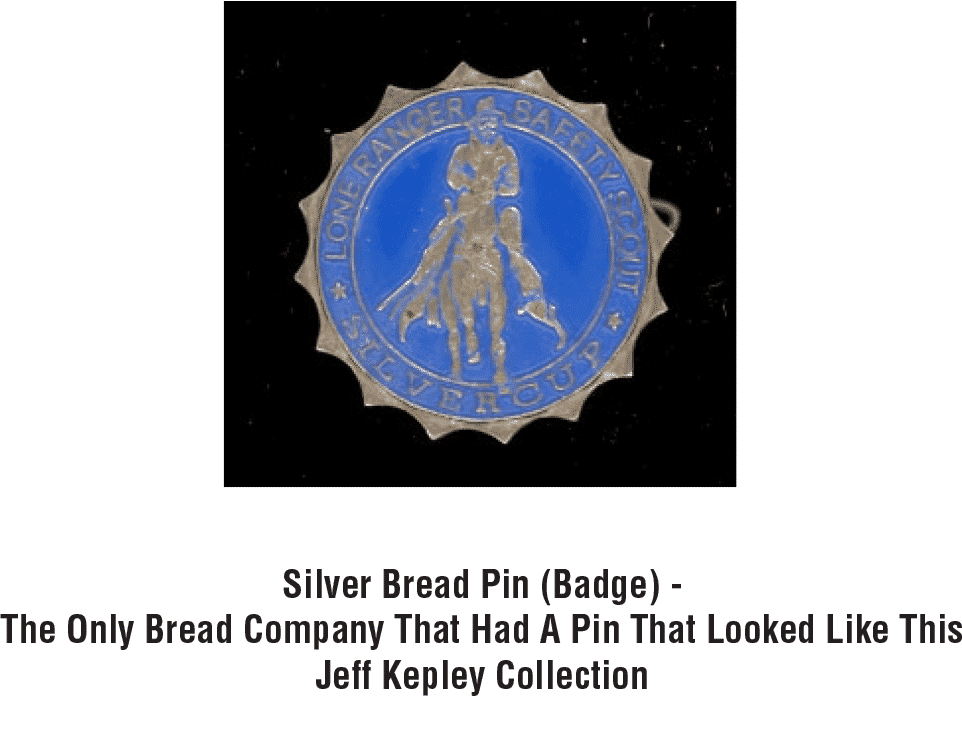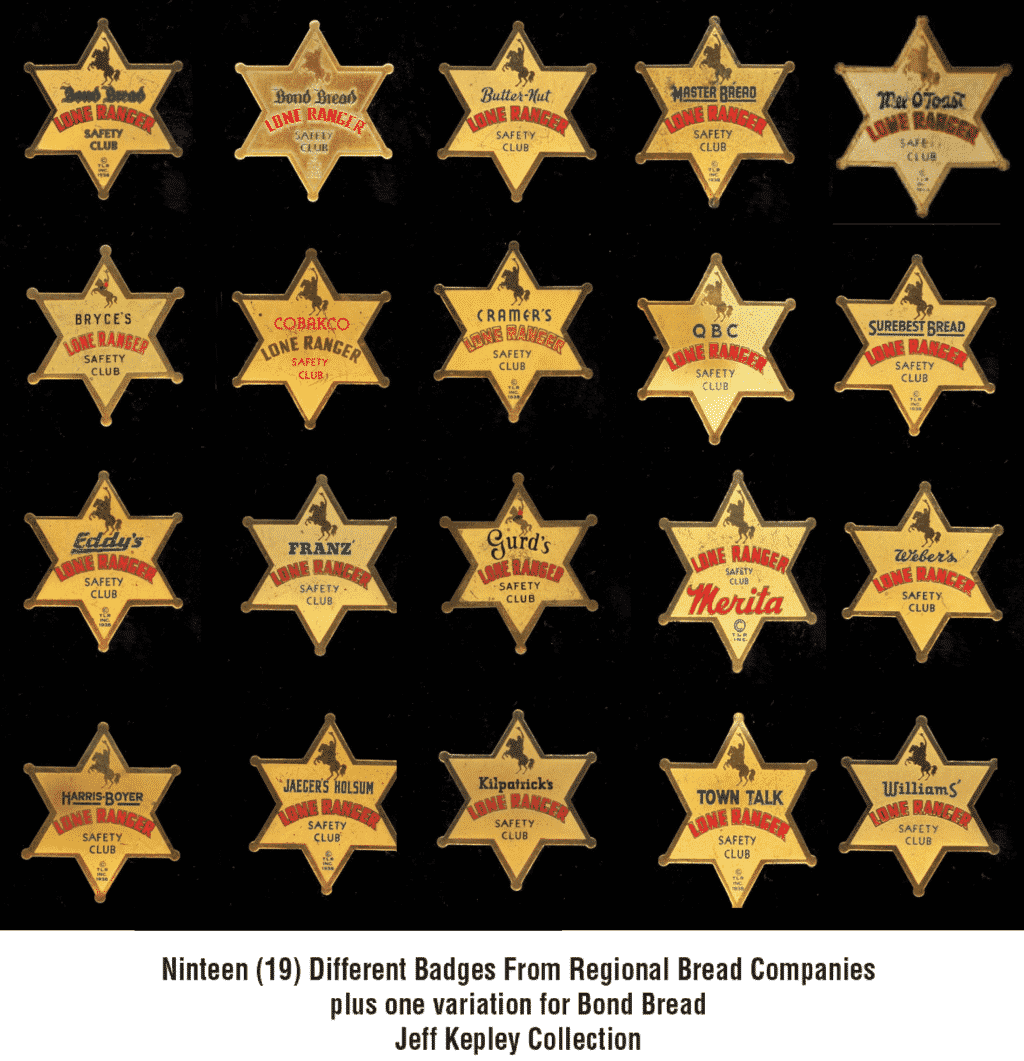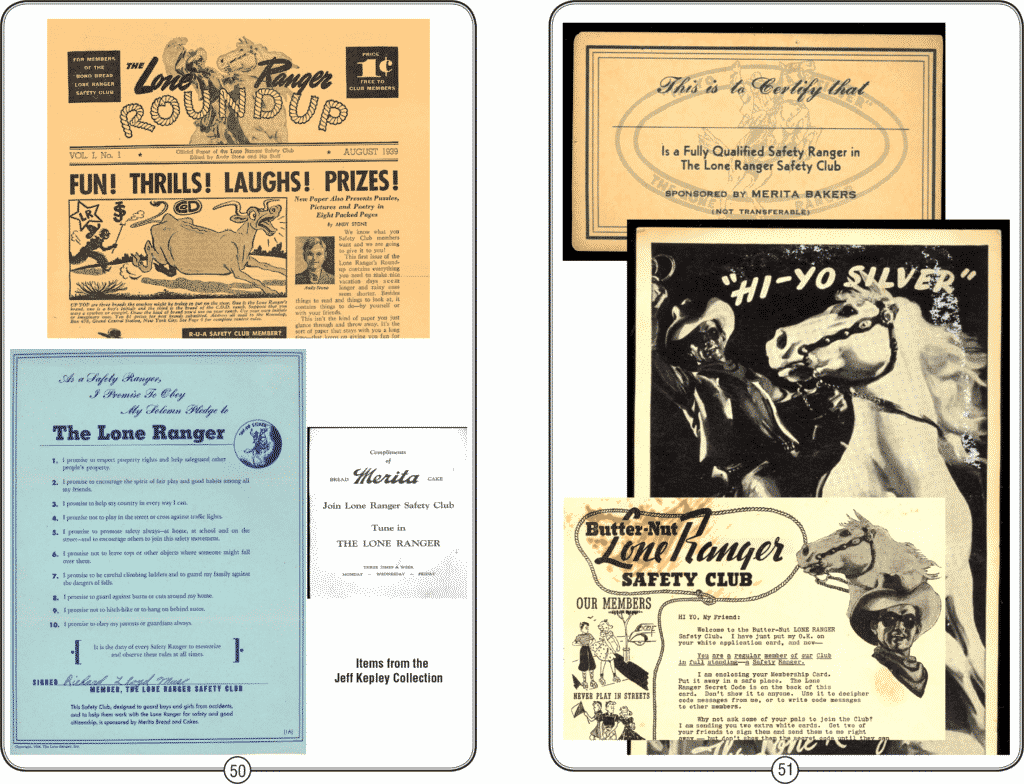A History of the Lone Ranger by Jeff Kepley
IN SEARCH OF “OUR LEGEND”
It was a pleasant Wednesday afternoon, not your typical hot July 3rd day in the Sacramento Valley. I was hoping and praying that the movie I was about to see would recreate and add to the legend that was started at a Detroit radio station 80 years ago. For me the mysterious masked rider of the plains stood head and shoulders above all other western heroes. He stood for justice, honor, integrity, fairness and was a champion for those who couldn’t stand against the forces of greed, corruption and evil.
He, more than any other western hero, gave a person a second chance. This mask hero spoke proper English, didn’t drink, smoke or swear and did not frequent saloons and gambling halls except in the line of duty. He was proud to be a “westerner” and never waited around to be thanked after seeing justice win out. Only a select few knew who he was or even saw his real face.
Soooo…… did last year’s movie stay true to the legend of the Lone Ranger that his creators carefully and dutifully developed over 20 plus years on radio? As I left the theatre I was asking myself, did I really just watch a movie about the Lone Ranger (I mean the Lone Ranger I grew up with)?? I’m still not sure if it was supposed to be a serious movie or a comedy?! Where were the characters that I cherished from the TV series, radio shows and books in a variety of formats (Big Little Books being one of them)??? How could Disney, successful producers and an accomplished actor miss the mark so badly (just my opinion)?????? As one fellow Lone Ranger collector (Mark Peetz) told me, it was a western movie about a masked man and an Indian, but it wasn’t about the Lone Ranger that we grew up with!!!
SO, how much do we really know about this Masked Rider who served Justice?
- Did the Lone Ranger have a horse before Silver???
- Did Tonto have a horse before Scout???
- Under the creative watchfulness of Striker, Trendle and Jewell, did the Lone Ranger ever have a first name?
- When and which media format specifically referred to Dan as the first name of the Lone Ranger’s brother??
- Was the ambush of the Texas Rangers always located at Bryant’s Gap??
- Was “Butch” Cavendish always the leader of the outlaw gang who ambushed the Texas Rangers???
- What was the name of the Lone Ranger’s nephew’s horse???
- When was it first mentioned that the Green Hornet was the great-nephew of the Lone Ranger???
- In the early introductions of the Lone Ranger radio show it stated that the Lone Ranger and Tonto served justice in seven (7) western states. Name the 7 states (Texas is a given)???
Some western states weren’t admitted to the Union until the late 1800’s and early 1900’s. What is your guess of the seven (7) states that the early opening to the radio show referred to? This map appeared in the 1939 Lone Ranger Safety Club – Official Manual.
After watching last year’s less than successful movie, I decided I needed to rekindle my memories of the REAL Lone Ranger. I started listening to the Lone Ranger radio shows in the car driving to and from work, I watched the early episodes of the TV series, the Republic Serials, read through most of the Big Little Books, several of the Grosset and Dunlap books, the Putnam book, various comic books and reference books that contained a great wealth of history of the character we all know as The Lone Ranger. In two early issues of the Big Little Times (BLT) Volume V, Number 2 & 5, Steve Graf wrote a great article on the Lone Ranger BLBs and the other type of books and the source/connection between the story lines. Several of the reference books were great insights into the individuals who created this great character. See the references at the end of the article for a listing of some great books on the Lone Ranger. My time spent researching was an enjoyable time and I would like to pass along some of the facts, questions and history that I came across. So let us return to “THOSE THRILLING DAYS OF YESTERYEAR!”
THE CODIFIED ORIGIN
Let’s start with what most of us know as the accepted Origin and Legend of the Lone Ranger. It was in the June 30, 1948 radio show:
- There were 6 Texas Rangers that rode into Bryant’s Gap.
- They were ambushed by the Butch Cavendish gang.
- Only one Texas Ranger survived, saved and nursed back to health by Tonto. Tonto gave the remaining ranger his name, “The Lone Ranger.”
- When they were boys, the Lone Ranger saved Tonto.
- Tonto dug 6 graves but only buried 5 Texas Rangers.
- The Lone Ranger’s first mask came from his brother’s vest.
- The Reid Brothers discovered and owned a silver mine before they became Texas Rangers. An old ranger friend, Jim Blane, worked the silver mine and supplied the Lone Ranger with silver bullets.
- Kemo sabe means trusty scout (or faithful friend).
- The Lone Ranger and Tonto came upon a silver horse in a death fight with a buffalo. The Lone Ranger saved “Silver.” They became partners in their fight for justice.
- The Lone Ranger found his nephew, Dan Reid, with Grandma Frisby near the Canadian border. Dan Reid’s mother was killed in an Indian attack on a wagon train headed for Fort Laramie.
- The Lone Ranger does not verbally say his own first or last name.
- The Lone Ranger does not verbally say his brother’s first name.
It took until 1948 for the origin of the Lone Ranger to be “Codified.” Why did the creators wait 15 years??? Well, to answer simply, they didn’t want anyone to know who he was (much like the “Shadow”). He was known as the “masked rider of the plains.” In the first public appearances of the Lone Ranger in the 1930’s, the creators were very deliberate in having the actor dressed up as the Lone Ranger (in most cases Brace Beemer who would later become the voice of the Lone Ranger in the 40’s and 50’s) never to be seen without the mask on. The creators didn’t want the identity of the actor playing the Lone Ranger on radio to be known to the public. Clayton Moore (who played him on television) did the same in his public and TV appearances. In the Lone Ranger radio and TV storyline, only a small handful of people knew him or saw his face without the mask. Clayton Moore (as the Lone Ranger) once guest starred on an episode of “Lassie” where he came to Timmy’s school to talk to the kids about buying U.S. Savings Bonds (see picture below). I got the chance once to speak with Jon Provost (who played Timmy) and I asked him about meeting Clayton Moore. He said that Clayton Moore always came to the set already dressed in his Lone Ranger outfit and never took off his mask!
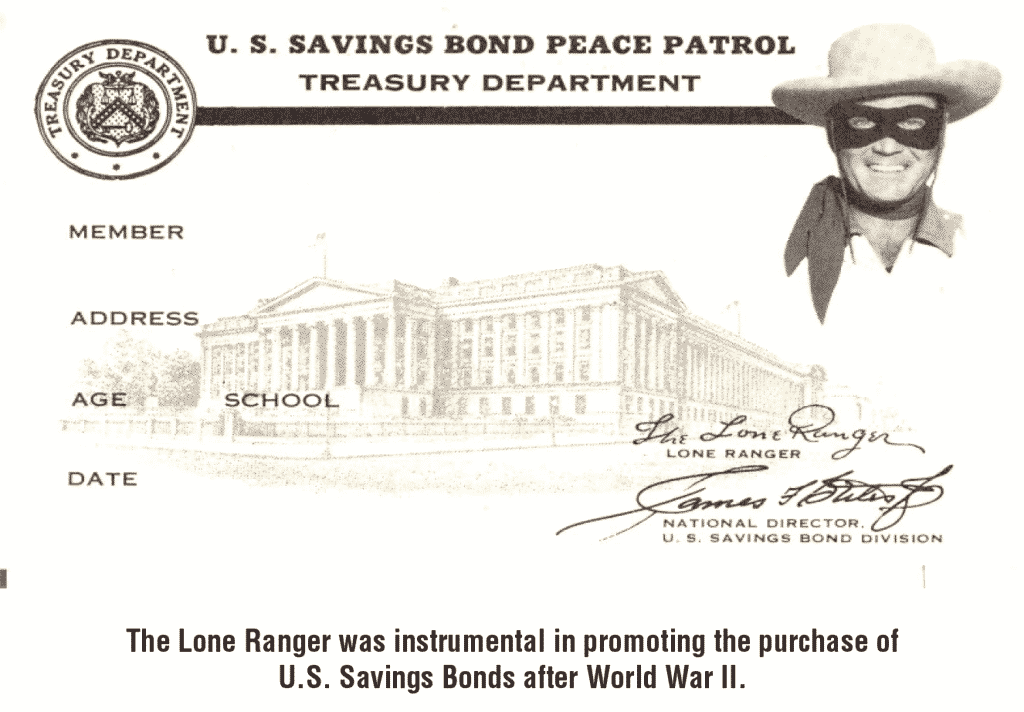
Speaking of Clayton Moore and the Lone Ranger TV series (which began in 1949), this is certainly my definitive portrayal of the Lone Ranger. If you were to watch the first three (3) episodes of the TV series, it was an almost exact re-enactment of the June 30, 1948 radio episode. One minor difference that I noted was, in the radio episode it was Tonto who thought to dig 6 graves but in the TV series it was the Lone Ranger who thought to dig the 6th grave after he recovered from his injuries.
But before this June 30, 1948 episode, there were radio episodes that presented different versions of several aspects of the origin of the Lone Ranger. Besides the radio episodes, the Grosset and Dunlap books, comic books and the first Republic Pictures serial touched on several early origin points. Not all of these origins were exactly the same as that presented in the June 30, 1948 episode. Let’s have some fun and go back to “THOSE TRILLING DAYS OF YESTERYEAR” and see how the legend of the Lone Ranger developed since its debut in January 1933.
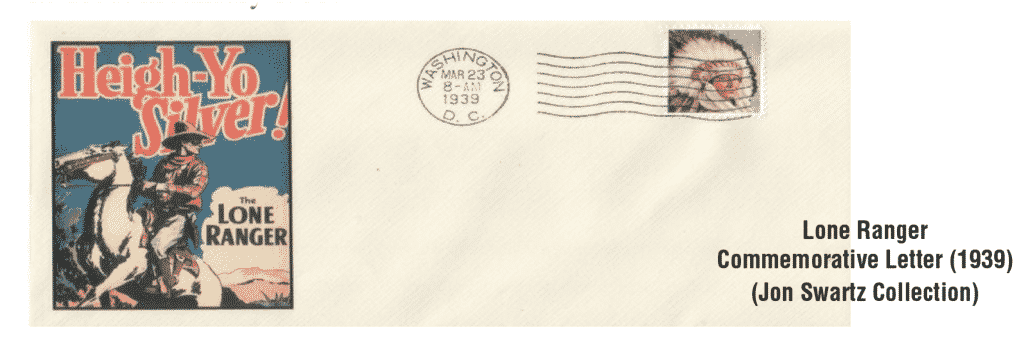
JUST HORSING AROUND
The Lone Ranger’s Horse(s)
In the June 30, 1948 radio episode (as well as the first TV episodes) the Lone Ranger rescues the great horse Silver after becoming the Lone Ranger. It is not really clear how much time elapsed from the time of becoming the Lone Ranger to finding the great horse Silver. He obviously had a horse when he rode into Bryant’s Gap as a Texas Ranger, but to my knowledge that horse’s name was never given in the “Codified Origin.” If we go back to the December 9, 1938 radio episode, the origin of Silver is presented. The origin is similar to the 1948 episode, but the storyline is broader and goes into more detail. The outcome is the same, as the Lone Ranger and Silver forged a bond of trust and friendship. Silver’s mother and father also star in this origin story in 1938. His father is King Sylvan (leader of the herd) and his mother is Moussa. Eventually his mother dies and his father is killed by “man” (see pictures below). Silver leaves Wild Horse Canyon and encounters a buffalo (see pictures below). The buffalo is one charge away from defeating Silver, but then two (2) shots ring out and the buffalo falls to the ground. The Lone Ranger has saved the great white horse and their partnership is forged. The 1941 Putnam novel by Fran Striker “The Lone Ranger Rides” also had this same origin of Silver that the December 9, 1938 radio episode presented except for one thing; – (in the 1941 Putnam novel, the Lone Ranger and Silver were already partners before riding into the ambush….hmmm….). A fabulous book entitled “FROM OUT OF THE PAST – A Pictorial History of The LONE RANGER” by Dave Holland mentions that there was another origin story of Silver in a 1935 radio episode. I couldn’t find the audio recording and can only speculate what the exact storyline was?

The following page shows part of the story – Silver fights a buffalo and The Lone Ranger intervenes and saves Silver
There is another important piece of horse trivia from the December 9, 1938 episode. The Lone Ranger had another horse before Silver. Her name was Dusty and she was an older horse. Sadly she couldn’t keep up with the outlaw’s horses and was shot while chasing the outlaws. As fate would have it, Silver was there to become the Lone Ranger’s partner in chasing down the outlaws. In this episode the Lone Ranger even called out “Hi-Yo Dusty!!” Doesn’t have quite the same ring as “Hi-Yo Silver”!!! This story was retold in the pages of the 1939 “Weber’s Lone Ranger Safety Club – Official Manual” (see pictures below). Does anyone know if another bread company issued their version of the Lone Ranger Safety Club – Official Manual??? This same story was told again (minus the name of Dusty) in the 1954 Cherrios promotional-comic “The Lone Ranger, His Mask, and How He Met Tonto” (see picture below).
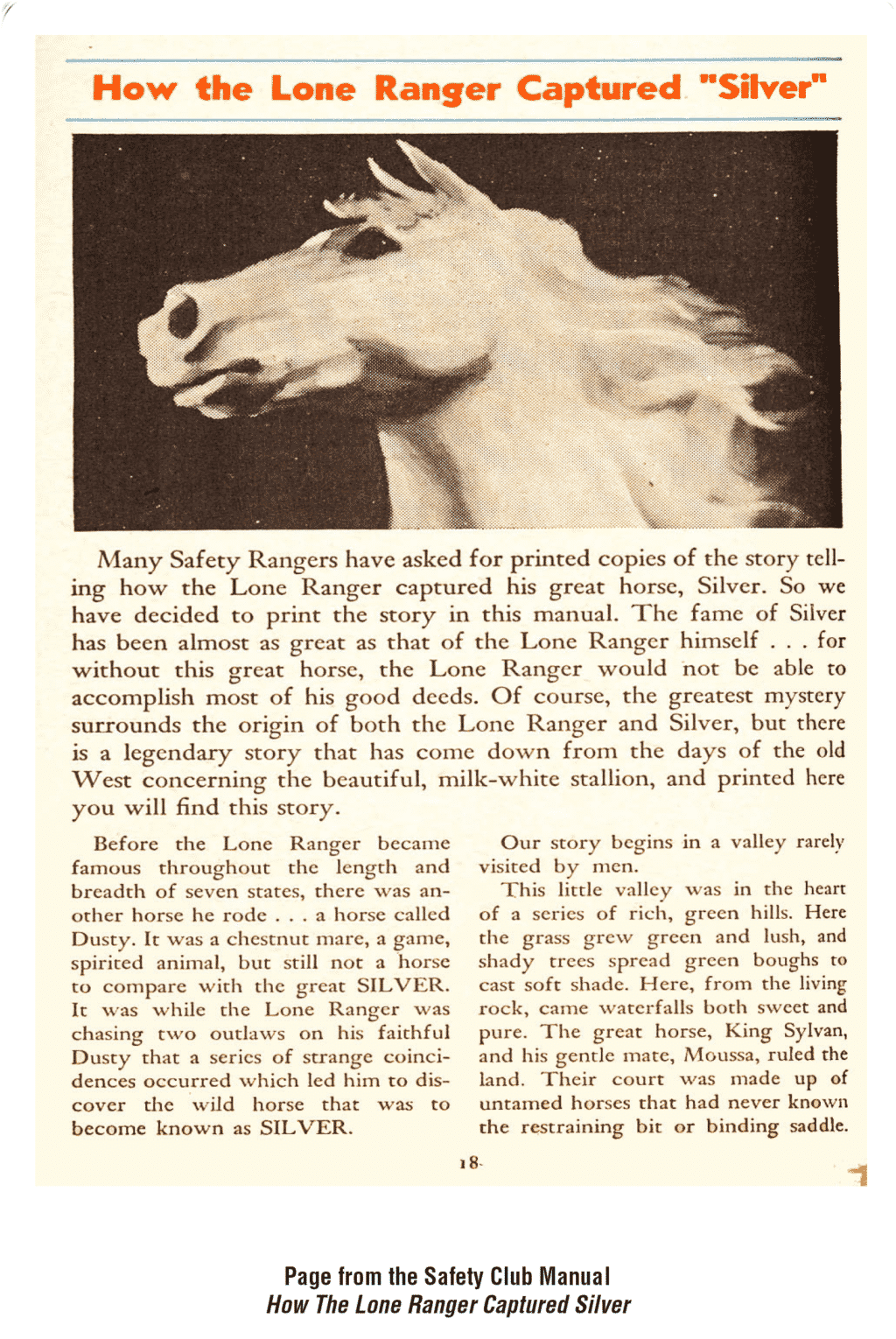
Now let’s go back to 1936 for another origin story of Silver. The Silvercup Bread Company produced a promotional comic entitled “How the Lone Ranger Captured SILVER” (see pictures below). The comic consisted of a wrap around cover with seven (7) loose pages (chapters) telling the complete story (on both front and back of each chapter). It was written by a 16 year old Lone Ranger fan, David Arnsan. The part where Silver fights the buffalo is in chapter 3 (the back side). Was this the first mention of the fight between Silver and the buffalo, or did the 1935 radio episode first mention the fight??? The seven (7) chapters (much like serials of the day) came out one a week for 7 weeks. Once you got all seven you could then punch holes and bind them together with yarn. The Lone Ranger’s horse was called “Nellie” in this story and was mentioned in chapter 2 (the front side). Nellie however is to share the same fate as Dusty, thus making room for the partnership between the Lone Ranger and Silver.
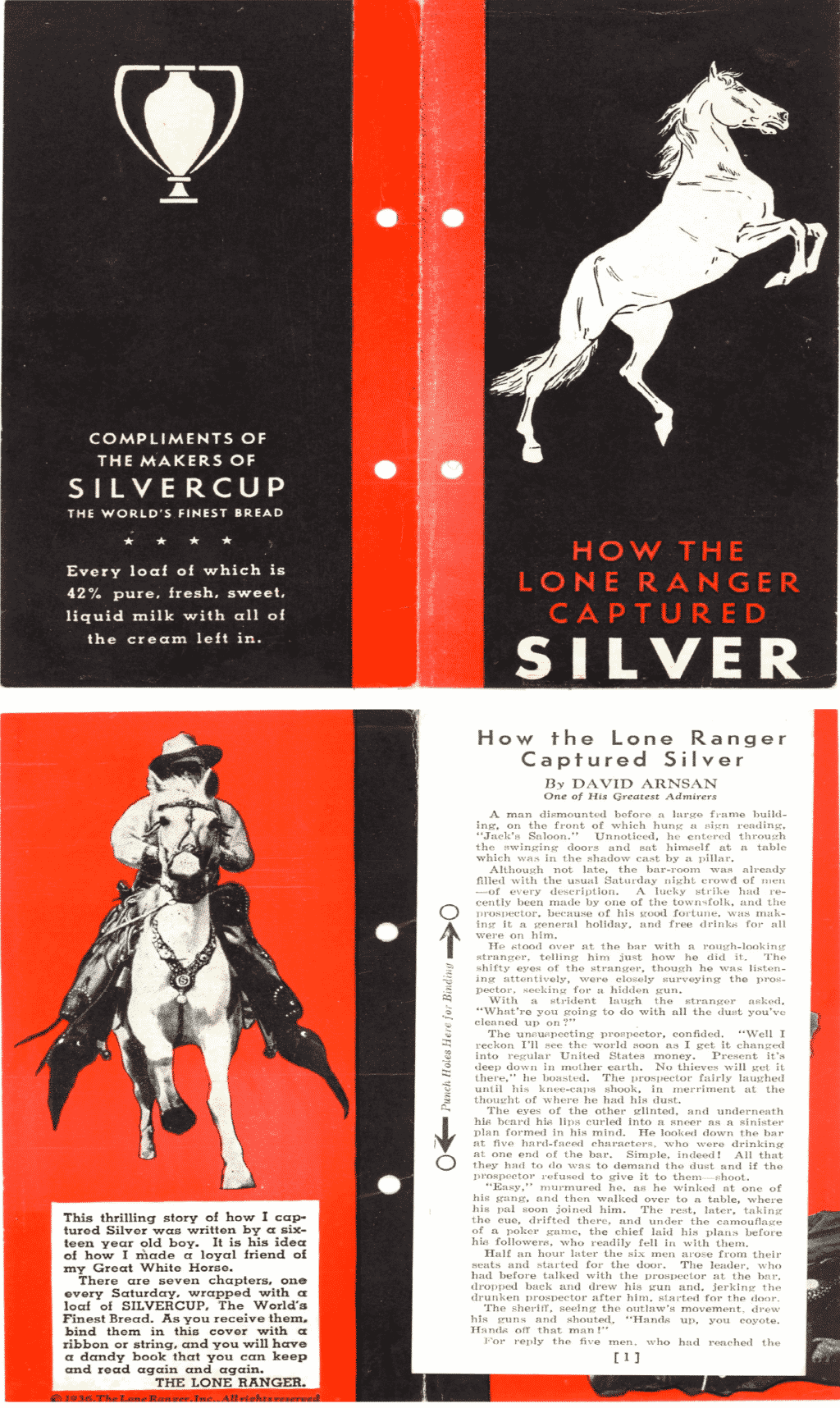
This picture shows the front and back of the wrap around cover of the 1936 promotional comic “How the Lone Ranger Captured SILVER.” Note the holes that can be used to tie all seven (7) chapters plus the wrap around cover together with yarn.
Tonto’s Horse(s)
Let us now shift our focus to Tonto’s horse. When did Tonto get Scout and did he have another horse before him? Perhaps we should first ask did Tonto always have a horse?? On radio, Tonto rode with the Lone Ranger on Silver until 1935, when he finally got his own horse. It was also a white horse called “White Feller.” Two white horses for our two heroes, easy for the radio listeners to visualize them in their own minds!!! So why, how and when did Tonto get his familiar “Paint Horse” Scout?? We skip ahead to 1938: Republic Pictures obtained the rights to film a Lone Ranger serial. They didn’t want the two heroes to have the same color horse on screen, so they decided to give Tonto a paint horse. With the pending movie serial coming out, the Lone Ranger’s creators set about the task of changing Tonto’s horse on radio as well.
In the August 5, 1938 episode (entitled; Four-Day Ride) White Feller sustained an injury during an occasion when the Lone Ranger and Tonto stopped two Indian tribes from fighting each other. The Chief of one tribe felt so indebted by the actions of Tonto, that he gave him his special horse (a paint horse) and in trade took White Feller in order to nurse him back to health. But for the next month, Tonto only referred to his new horse as “Paint.” It wasn’t until the September 2, 1938 episode that Tonto finally name him “Scout.” Question – can you guess the name of the Indian Chief that gave Tonto the paint horse? You guessed it, Chief Thundercloud, which just happened to be the name of the actor who portrayed Tonto in both of the Republic serials.
If we go back to an early radio Episode, September 30th, 1935, we see a slightly different version of how Tonto gets a horse, as documented in the book “From Out of the Past – A Pictorial History of The Lone Ranger.” In this episode Tonto gets his own horse courtesy of Silver. Silver was acting fidgety when they neared Wild Horse Canyon and he took off only to return at the end of the episode with a friend, another big white stallion. This horse became Tonto’s “White Feller.”
Comparing the storyline for Tonto’s horse in the Grosset and Dunlap books with the radio episodes, we find that the first book (Lone Ranger – written by Gaylord Dubois) made no mention of the name of Tonto’s horse (Dubois was probably influenced by the early radio scripts before Tonto got White Feller in 1935). The second book (Mystery Ranch – written by Fran Striker) has both the Lone Ranger and Tonto with white horses (obviously using the radio scripts after Tonto got White Feller). In the third book (Gold Robbery – written again by Fran Striker) Tonto now has his famous paint horse “Scout.”
Covers of the first 3 Grosset and Dunlap books
Meanwhile in the Big Little Books things are a little bit different with Tonto’s horse. The first BLB (most likely adapted from an early radio script) had Tonto with no horse and riding with the Lone Ranger. The next four BLBs (all written by Gaylord Dubois) have a variety of descriptions for Tonto’s horse; first book by Dubois – Horse of non-descript, second book – Non-descript bay pony/shaggy pony, third book – No horse for Tonto and fourth book – Rough coated bay pony. It wasn’t until the sixth BLB (which was the first one written by Fran Striker) did the great horse Scout show up!!
Nephew Dan Reid’s Horse
It was December 1942. WXYZ radio broadcasted a five-part storyline of how the Lone Ranger found his nephew. This storyline was the basis of the Grosset and Dunlap book – “Rides North.” The storyline took the Lone Ranger and Tonto all the way to the Canadian border. When Dan’s substitute grandmother (Grandma Frisby) died, the Lone Ranger made a promise to take care of Dan. As they made their way south to Texas, the Lone Ranger promised Dan a surprise when they reached Mustang Mag’s ranch (this occurred in the December 30, 1942 episode). The announcer at the end of that program even reminded the listeners that there was to be a surprise for Dan when they got to Texas. That surprise was to be a magnificent horse! The radio creators had introduced this horse in an episode several months prior to the Lone Ranger finding his nephew!!
Before Dan, Tonto and the Lone Ranger reach Texas so Dan can meet his new horse; let’s first go back to the August 13, 1941 radio episode (entitled “Son of Silver”). Silver takes off by himself to Wild Horse Canyon (where Silver grew up). The Lone Ranger and Tonto followed him. There they discovered that Silver had a 2-year old son. The Lone Ranger left Silver’s son in the care of Mustang Mag with two stipulations; 1) – It would be the Lone Ranger’s horse if something ever happened to Silver and 2) – The Lone Ranger would get to name the horse. Now fast-forward to January 1, 1943, the Lone Ranger, Tonto and Dan start heading south but find many adventures along the way. By the February 17, 1943 episode, the three still haven’t made it to Mustang Mag’s ranch. The next radio episode that I have a copy of is March 1, 1943. In this episode the three have already made it to Texas and Dan is trying to learn to ride his young white horse. By the end of the episode, he is finally victorious at staying in the saddle when the horse jumps the fence. This leads Dan to name his horse “Victor.”
TONTO
Tonto and the Lone Ranger’s friendship didn’t start after the brutal ambush in Bryant’s Gap where Tonto saved and nursed the Lone Ranger back to health (see picture below). The TV series, the 1948 radio episode and the 1941 Putnam novel all tell about how they knew each other as boys. The Lone Ranger saved Tonto after his tribe was ambushed by renegade Indians. Tonto called the Lone Ranger Kemo sabe (or kemo sabay – see later in this article) which means “Faithful Friend.” or (“Trusty Scout”). This is now the “Codified” version of Tonto. But when Tonto was introduced in the 11th episode in February of 1933, he was a half-breed. And as the early radio storyline goes, the Lone Ranger met Tonto when he saves him from a landside in the gold mining country where one of the bad guys wants to kill Tonto. This version was presented several times, even as late as December 7, 1938, with Cactus Pete (a friend of Tonto’s and the Lone Ranger) telling the story around a campfire. As Cactus Pete was telling his story, he even alluded to the possibility that Tonto may have saved the Lone Ranger after an ambush (read about the ambush later in this article)??
This story of Tonto’s origin was told again in a Merita Bread give-away entitled “The Life of Tonto” in 1940. I unfortunately have never seen this give-away, so I would be very interested in knowing the specifics of the storyline if anyone has it. Oh by the way, did you know that Tonto nearly got married on a radio episode?? It was February 3, 1936, Old Chief Thundercloud (boy they used that name a lot for the name of an Indian Chief) made a plea with Tonto to give up his constant traveling and become the new Chief of the Tribe and marry his daughter Dawn Flower. But alas, his constant traveling to serve justice with the Lone Ranger won out and he never married Dawn Flower.
A critical part of the legend of the Lone Ranger is; who saved him?? From most all accounts, whether radio, TV or books, there is little doubt that it was Tonto who saved the Lone Ranger after he and the other Texas Rangers were ambushed. Tonto dug the graves for each of the rangers. But hold on to your skirts, what if a girl had actually saved the Lone Ranger after the ambush and before Tonto arrived???? Let us go back to a very crucial year in the life of the Lone Ranger. That year was 1941!
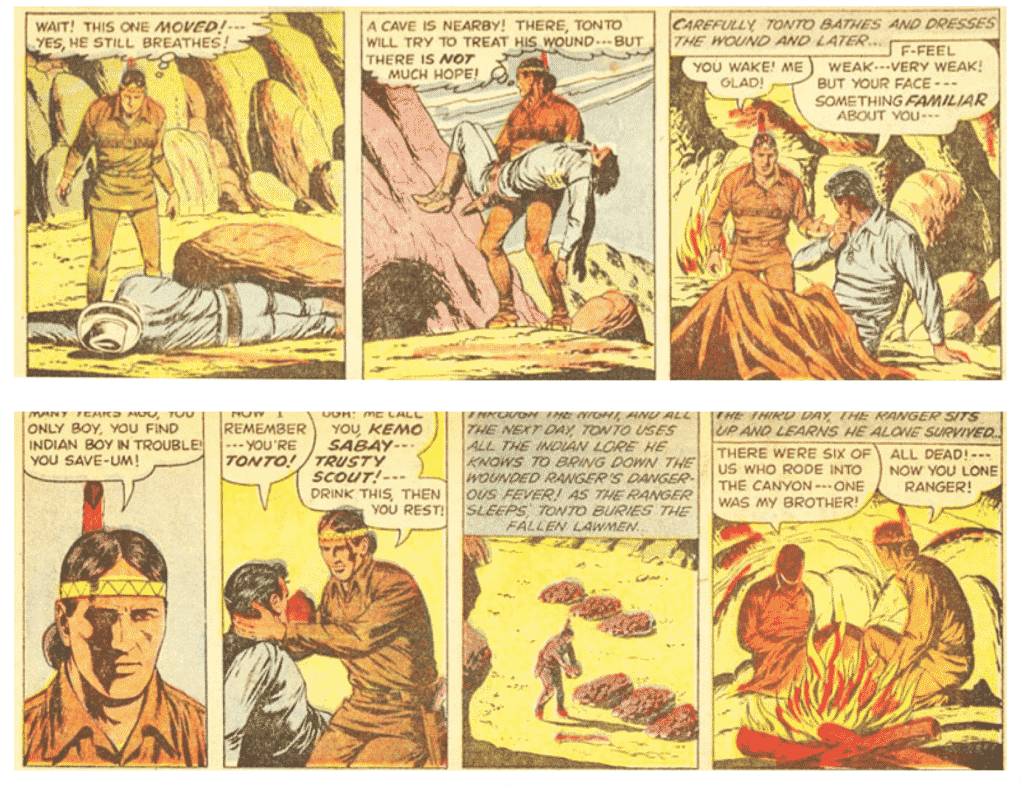
The first actor that truly gave life to the Lone Ranger character, Earle Graser, was killed in an automobile accident in April of that year. Five episodes later, another radio actor, who was occasionally the announcer for the show, became the next voice of the Lone Ranger. His name was Brace Beemer and would be the voice until the end of the run on September 3, 1954. Brace and the creative team wanted to put a new spark to the radio show that played three nights a week. The origin and background of the Lone Ranger started to become clearer, multi-part episodes and long range plots were more frequent, but none more than the Lone Ranger’s continuous battle with the clever villain Black Arrow, which lasted more than 60 episodes. The episode that kicked off the era of new Lone Ranger action aired on October 13, 1941 and was entitled “A NEW MISSION.” This episode had President Grant meeting with the Lone Ranger in St. Louis and the Lone Ranger telling of the ambush where Texas Rangers were gunned down, six graves were dug but only five men died.
What about Tonto and this girl (Joan Barkley – a female agent) that may have saved the life of the Lone Ranger??? It was during this multi-part storyline with the Black Arrow that Joan was introduced (this episode aired on December 1, 1941). She was from Texas and her brother was a Texas Ranger. She rode to meet him at Grant’s Pass when she heard shots. She found one man with a spark of life (not her brother), so she dressed his wounds, gave him water and tried to get him on her horse but she could not. She then went to get help. But before she could return, Tonto had found the Lone Ranger and the rest is history. In the dialogue there was mention that Tonto and the Lone Ranger knew each other as young boys, but there was no mention of the Lone Ranger’s older brother being one of the rangers that was killed. As the legend of the Lone Ranger and Tonto became “Codified,” Tonto is solely credited with saving the Lone Ranger and the actions of this Texas girl faded away.
In 1933, Tonto started out as a half-breed who was older and not physically strong. In the old west, a half-breed was usually thought of as an outlaw. As Tonto’s role became more prominent and as his status evolved to more of a partner to the Lone Ranger, his image needed to be elevated. In an episode on April 29, 1936, his transition to full blooded Indian occurred. He also became the son of a Chief in the 1941 Putnam novel (see picture below).
Fran Striker also wrote in this Putnam novel that our two heroes knew each other as young boys (this is where the Lone Ranger saves Tonto). So what tribe was Tonto from??? If you believe that Tonto was from West Texas (the Lone Ranger was after all a Texas Ranger), then a Comanche or Apache would seem logical. In the BLB “The Lone Ranger and the Lost Valley, DuBois called Tonto an Oglala Sioux Indian. Since Tonto first started off as a half-breed, Trendle, Striker and James Jewell probably weren’t too concerned with what tribe he was from. So where in his evolving origin did Tonto become a Pottawatomie Indian (also spelled Potawatomi)?? Perhaps it was as simple as the fact that the Pottawatomie Indians lived in Michigan and that this is where the radio shows were broadcast from!!
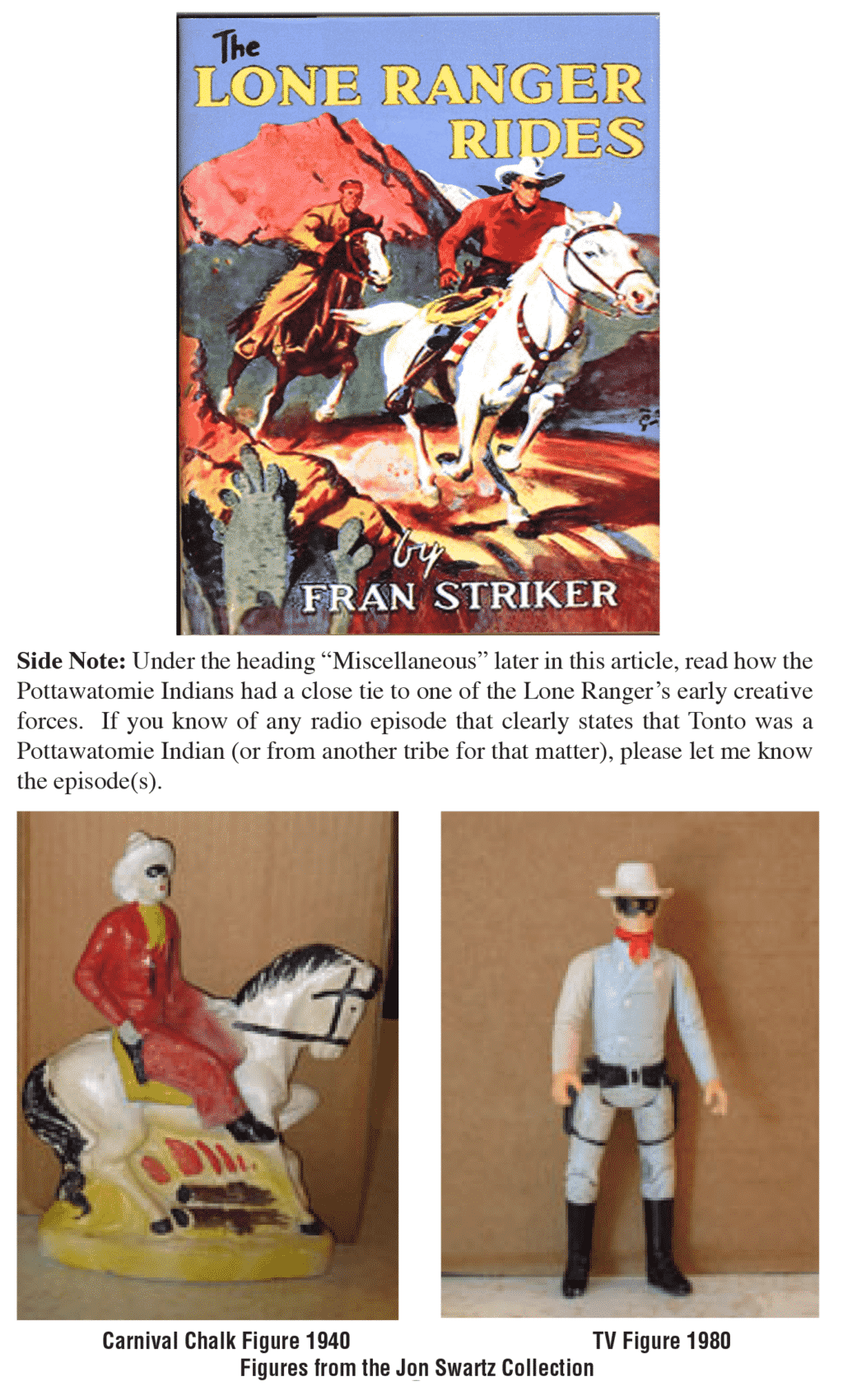
THE AMBUSH AND THE LEADER OF THE OUTLAWS
In the beginning, the Lone Ranger did not have a recorded past. That appears to be the way creators George Trendle (the businessman who wanted a western character for his radio station) and Fran Striker (the writer who created the Lone Ranger with his written words) wanted it. As time went on, audiences wanted to know more about who this masked rider of the plains was. But the origin of the ambush storyline was not conceived by Striker or Trendle, but by Republic Pictures who gave us two serials. The writers and producers at Republic may not have followed the radio storylines very closely, but they did have an impact on the Legend of the Lone Ranger moving forward. So with the release of the first serial in 1938, the ambush storyline was now presented to the public. Fran Striker, in his novels and radio scripts would start referring to the ambush, but it appears that it wasn’t until the 1948 radio episode that all the “Codified” pieces were put into place.
Bryant’s Gap is the accepted “Codified” location of the ambush. But was it the location when the ambush storyline began? The first Republic serial in 1938 named the place “Grant’s Pass.” This name was also used in the December 1, 1941 radio episode where the female agent, Joan Barkley, told President Grant that her brother was one of the Texas Rangers that was ambushed at Grant’s Pass. By the December 25, 1942 episode, (where the Lone Ranger finally confirms that Dan Reid is his nephew) Fran Striker’s radio script identifies the ambush location as Bryant’s Gap! In Fran Striker’s novel length story for Putnam in 1941, Bryant’s Gap was also the location, but with a twist of why it was named that. The Cavendish gang/family owned the land on one side of the gap and the patriarch was ‘BRYANT” Cavendish!! But the version I find most interesting is found in the 2nd Grosset and Dunlap book “Mystery Ranch” in 1938. The Lone Ranger is after a gang of hooded outlaws called the “Night Legion” when he comes upon a man left for dead by the “Night Legion.” On pages 12 and 13 (see picture below), the Lone Ranger thinks back to a few months earlier and remembers it was the “Night Legion” that surrounded him and his fellow Texas Rangers around their camp and ambushed them. And yes it was Tonto who came to the scene after the Night Legion rode off.
Butch Cavendish is the accepted “Codified” leader of the Outlaws. In the TV episodes, actor Glen Strange (who later became the bartender on Gunsmoke) portrayed Butch Cavendish. To the best of my knowledge, the name “Butch” was first used in the June 30, 1948 radio episode. Before that, in the 1941 Putnam novel, Bryant Cavendish is the head of the Cavendish gang/family, but it is his nephews who were responsible for the ambush, not him. In the Republic serial, Snead is the leader of the gang who ambushed the Texas Rangers. In the 2nd Grosset and Dunlap book “Mystery Ranch” the leader of the “Night Legion” is Grant Whitcomb.
THE REIDS
One of the most important premises of the Lone Ranger’s mystic is that very few people knew who he really was. Tonto didn’t even see his face until about 2 years after the radio show began!! The Lone Ranger stated many times that his identity MUST be forever lost. When Grandma Frisby was dying, the Lone Ranger tells Dan and everyone else to leave the room before he unmasks for Grandma Frisby. He tells it this way to President Grant on the October 13, 1941 radio episode, “If my identity were known, my usefulness would be at an end.” So why did the 1981 film and last year’s film give him the name of John?? Where did the name of John come from, especially since the original creators went to great lengths to keep his identity and past a secret?? I was told by Jim Nixon (Lone Ranger radio expert) that in the book entitled “The Big Broadcast” printed in the 1960s and written by Frank Buxton and Bill Owen, they put forth the name of John as the Lone Ranger’s first name and others picked up on that and have used it ever since. It is my contention that Fran Striker and George Trendle would never have given the Lone Ranger a first name. If they wanted him to have a first name they would have done so sometime when the radio show was on the air from 1933 to 1954!! Some have said that the name John was mentioned in the 20th anniversary show (January 30, 1953), but I have listened to that episode twice and did not hear the name John used.
Dan Reid, the Lone Ranger’s nephew joined the cast in December of 1942 and rode with his uncle and Tonto till near the end of the radio series (and on into the TV series). Dan became the Father of Britt Reid (the Green Hornet). The Green Hornet radio show began airing in 1936. But it wasn’t until the November 11, 1947 episode that the connection between the Green Hornet and the Lone Ranger was made public. Dan Reid finally found out that his son Britt was the Green Hornet. He was very proud and showed him a picture of his great-uncle and said that his uncle would also be proud of him. Frank Striker brings it full circle in the Lone Ranger’s 20th anniversary show (January 30, 1953) when he tells Dan that he should grow up and have a son that will fight for justice. The Lone Ranger also tells Dan that he needs to get an education back east and that he will inherit the silver mine some day.
As far as the Lone Ranger’s older brother, I don’t think many people would disagree that his name might have been Dan Sr., but I am having trouble finding the first time the name of Dan was directly and clearly mentioned by someone on a radio episode!! To my knowledge, the Lone Ranger never says his brother’s first name (on a radio episode or the first three TV episodes). He calls him Captain Reid or my older brother. If someone knows of a radio episode that the Lone Ranger clearly says “Dan” for his brother’s first name, please let me know. In the book “Who Was That Masked Man” by David Rothel, there is a copy of the 20th anniversary show “Call Sheet” (January 30th, 1953) that lists the characters name, the actors names and the production people, and it is autographed by everyone (man what a treasure that would be)!!! On this “Call Sheet” the Lone Ranger’s brother is only referred to as “Capt. Reid”
Dan Reid Sr. is mentioned in later issues of the Lone Ranger comic books. Dell comic #105 (dated March 1957) uses the name Dan and so does the Cherrios promotional comic (from 1954) entitled “The Lone Ranger, His Mask, and How he met Tonto” (see picture below). Not sure why the comic books started calling him Dan??? The first time that the Lone Ranger’s brother is mentioned as the captain of the Texas Rangers is in the December 25, 1942 episode, and from there on, he was the man in charge of the Ranger’s that were ambushed, leaving his younger brother as the sole survivor. Side Note: – The 1941 Putnam novel did not have Captain Reid as one of the six rangers that were ambushed….hmmmmm….
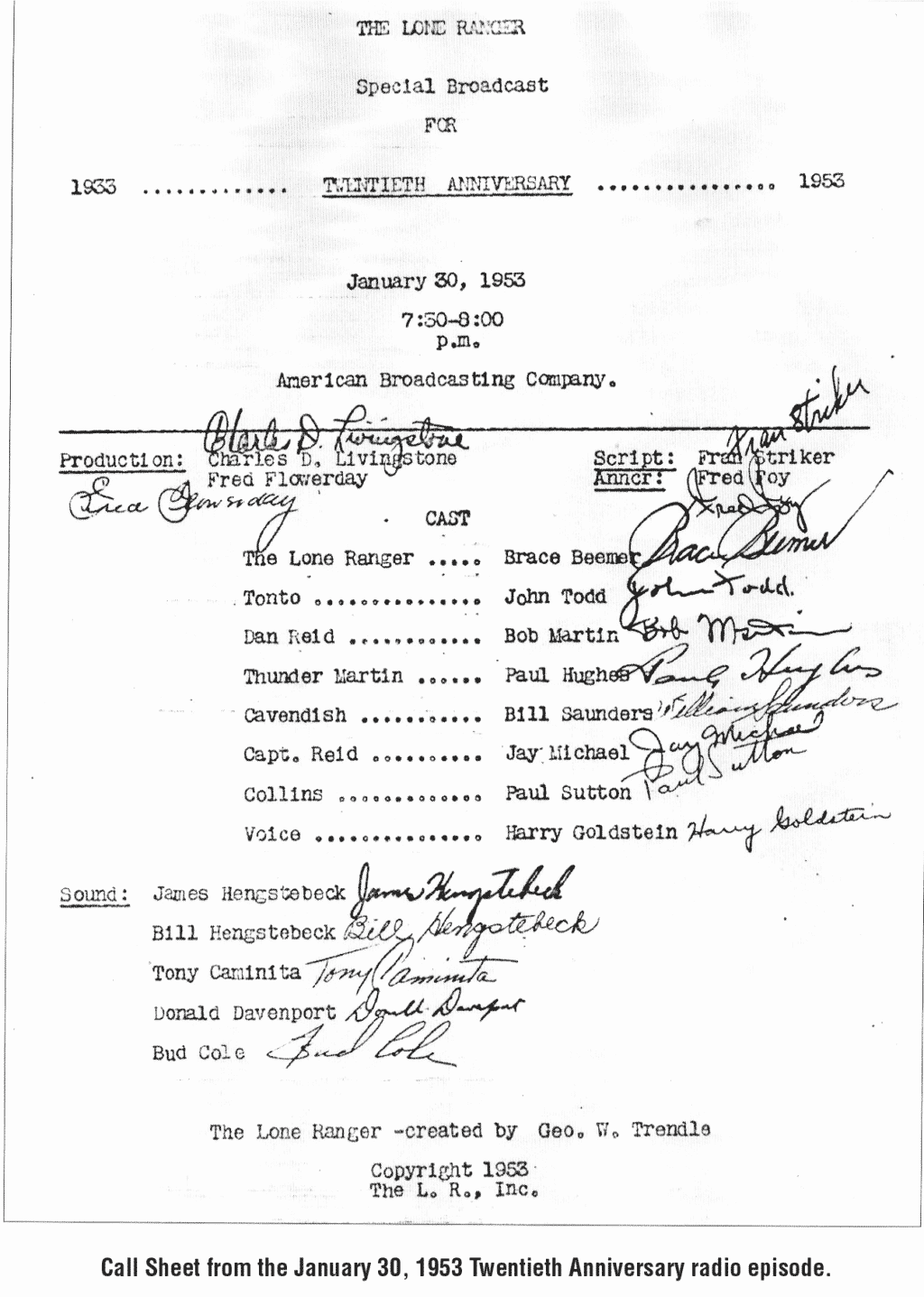
MISCELLANEOUS
Everything Silver;
As the 1948 “Codified” legend goes, the Reid brothers discovered and owned a silver mine before they became Texas Rangers. They were going to work it once they retired. But after the ambush, the silver mine became the source of bullets, horseshoes and what little spending cash the Lone Ranger needed. On radio, TV and in comic books, a former Texas Ranger and friend, Jim Blane, managed the mine for the Lone Ranger (see picture below).
So if the story of the Reid’s silver mine and the former Texas Ranger friend (Jim Blane) who worked it didn’t become part of the Lone Ranger legend until 1948, how did the idea of silver bullets develop from the inception of the first radio episodes???
Credit is given to Fran Striker for creating the silver bullet angle at the onset of the radio adventures. A secret silver mine where the Lone Ranger could get a steady supply of silver bullets and cash was probably not foremost on his mind. The silver bullets was most likely conceived by Fran Striker to give the Lone Ranger a calling card for intimidating outlaws but bringing hope to law abiding citizens (much like Robin Hood and his silver tip arrows). As the legend of the Lone Ranger grew, the expensive silver bullets would be a constant reminder that human life was precious, so pulling the trigger was not to be done capriciously.
So where did the silver bullets come from before 1948 and who made them?? I don’t know of any early radio episode that mentions a silver mine or how the silver bullets were made or who made them?? If anyone knows of a radio episode that mentions the silver mine, please let me know. In the first Republic Pictures serial (1938), the local blacksmith made the silver bullets for the Lone Ranger. So perhaps another first should be credited to Republic Pictures for trying to come up with a plausible scenario of how the Lone Ranger came to have silver bullets!! In the 1941 Putnam novel, Tonto is the one who comes up with the idea of the silver bullets after the Lone Ranger recovers from the wounds received from the ambush……hmmmmm…..
Who named “The Lone Ranger”
George Trendle, the businessman with the money and a radio station, conceived the idea of a western radio show. Trendle had the final say in how the character of the Lone Ranger was handled and marketed. He was also the main moral compass for how the Lone Ranger would conduct himself. But Trendle did not name his radio station’s new western character.
James Jewell directed the half-hour Lone Ranger dramas from the inception of the radio show until he left in the late 30’s. He also put together a stock company of actors that did most of the acting for WXYZ radio station. He was very involved in the development of the Lone Ranger character with his editing of scripts and suggestions (one of the biggest ones being “kemo sabe”). Perhaps his biggest contribution was asking Fran Striker to create and write the Lone Ranger scripts after he unsuccessfully tried to write the first radio scripts for this new western adventure. Jewell did not give the Lone Ranger his name either.
Fran Striker was a very prolific writer. Before the Lone Ranger show he was writing his own scripts and syndicating them to various radio stations. When James Jewell couldn’t develop a good enough script that would meet George Trendle’s expectations for his newly conceived western radio show, Jewell contacted Fran Striker to do the chore. Trendle accepted Striker’s script and the rest is history. The first Lone Ranger script was actually a re-worked script from one of Striker’s own radio creations called “Covered Wagon Days.” Nor did Striker give the Lone Ranger his name.
Harold True was an announcer and studio manager for WXYZ radio. It is written that Harold True gave the name of Fran Striker to James Jewell, when Jewell was looking for fresh new scripts to fill air time. It is also written that Harold True’s big contribution to the Lone Ranger radio show was the naming of the character and the show.
As one of Fran Striker’s sons would say, the Lone Ranger was not created but evolved. All of the people above, plus others, had a hand in the development of the character that we all know as the “Lone Ranger.”
Kemo Sabe
What did “Kemo sabe” mean, who came up with it and how do you spell it??? Most people would credit James Jewell with coming up with the term “Kemo sabe” (the spelling most often seen). Through the years there have been different spellings of “Kemo sabe” but where did it really originate from? Jewell”s father-in-law ran a summer boys camp in Michigan which began in 1915. It was called KAMP “KEE-MO SAH-BEE.” On the copies of the radio scripts that belonged to James Jewell, he spelled it “kemo sabay.” In the 1930’s, after the Lone Ranger radio show became a success, the camp was renamed to “The LONE RANGER CAMP.” In the book “From Out of the Past – A Pictorial History of The Lone Ranger” there is a picture of a flyer for “The LONE RANGER CAMP” and an earlier picture of the tents that those lucky boys got to sleep in! The picture with the tents has the camp spelled out as “KAMP KEE-MO SAH-BEE.” The letter sent to the young Safety Club fans by Silvercup Bread had the spelling the same as the Kamp (see picture below). The picture of the flyer advertising “The LONE RANGER CAMP” has the instructors of the Indian activities as “Full Blooded Pottawatomie Indians” (see picture below). So guess where the name of Tonto’s tribe originated from???
But what did Kemo sabe stand for. Two definitions stand the test of time. One is “Trusty Scout” while the other is “Faithful Friend.” Most people would agree with “Faithful Friend” as if fits the relationship and respect that the Lone Ranger and Tonto had for each other. James Jewell insisted that it only meant “Trusty Scout” (note what the letter from Silvercup Bread says).
THE LONE RANGER SAFETY CLUB
The Lone Ranger became one of the most merchandised characters of all time. But the merchandising was always to be within the standards and expectations that the Lone Ranger represented to his young fans (old fans as well). Perhaps the biggest Lone Ranger promotion was that of the “Lone Ranger Safety Club.” It was started on the October 13, 1935 radio broadcast (#422). The Lone Ranger took a few minutes to talk directly to his young fans and there was also introductions of several dignitaries like the Mayor and Police Commissioner of Detroit. The purpose of the club was to help reduce the many terrible accidents, deaths and crippling injuries caused by automobiles. BOY, don’t we need something like that today??? The previous picture of the letter from Silvercup Bread lists 10 things each Safety Club member is to do.
Silvercup Bread was the first club sponsor and the President of Silvercup Bakeries was also introduced on the October 13, 1935 broadcast. But the only kids who could join the club were those who were within the territory where Silvercup Bread was sold. Kids had to go to a market where Silvercup Bread was sold in order to get a form to mail in to join the club. This move forced the other sponsoring bread companies to also create Safety Clubs in their region of the country.
The Safety Clubs spread throughout the country. Promotional material was sent to radio stations for them to mail out to the young fans in their region. A member would receive a membership card (with a code to write and receive secret messages), a pledge card and a badge denoting the bread company in their region (see pictures below). There was also a Safety Club manual.
Ted Hake (premium pin collector extraordinaire) says there are four (4) more badges that he knows about. Ted is the founder of Hake’s Americana Auction. The four badges are;
- B. Poe
- Bestyett
- Gatelys
- Roths
While reading through the reference books on the Lone Ranger I came across two (2) other bread companies that were mentioned as having a relationship as a sponsor with the Lone Ranger radio show. The two were Gingham Bread and Brown Bread. I do not have any confirmation that there was a badge for either of these companies. If anyone knows if a Safety Club Badge was made for Gingham Bread or Brown Bread, please let me know!!!
Selected Bibliography:
Rothel, David, Who Was that Masked Man? – The Story of the Lone Ranger, Nashville, Tennessee: Riverwood Press, 2013.
Holland, Dave, From Out of the Past – A Pictorial History of the Lone Ranger, Granada Hills, California: The Holland House, 1989.
Warner, Jennifer, The Unofficial Lone Ranger Biography, San Bernardino, California: LifeCaps, 2012.
Striker, Fran Jr., His Typewriter Grew Spurs, Lansdale, Pennsylvania: Questco, 1983.
Van Hise, James, Who Was That Masked Man? – The Story of the Lone Ranger, Pioneer Books Inc: Las Vegas, Nevada, 1990.
People who contributed to this article and to whom I am very grateful:
Ted Hake
Mark Peetz
Jim Nixon
John Gassman
Don Maris
The Lone Ranger ©Comcast-NBC Universal
Join us for more discussion at our Facebook group
check out our CBH documentary videos on our CBH Youtube Channel
get some historic comic book shirts, pillows, etc at CBH Merchandise
check out our CBH Podcast available on Apple Podcasts, Google PlayerFM and Stitcher.
Images are not intended to infringe on copyright, but rather for academic purpose.








